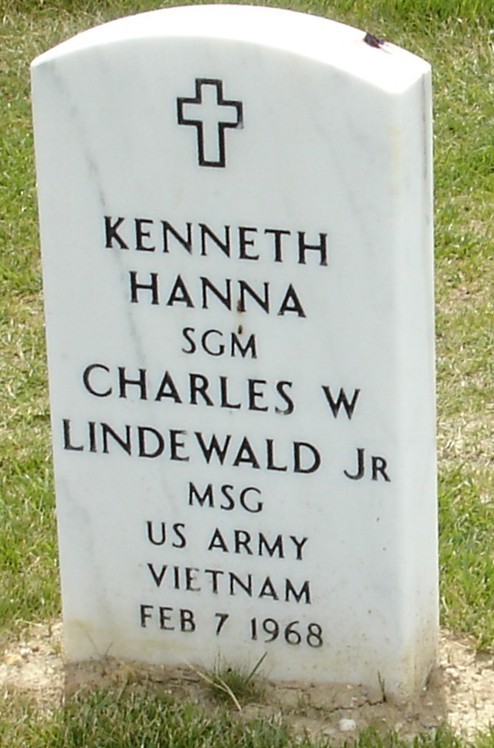- Full Name: KENNETH HANNA
- Date of Birth: 4/28/1933
- Date of Casualty: 2/7/1968
- Home of Record: SCRANTON, SOUTH CAROLINA
- Branch of Service: ARMY
- Rank: SMAJ
- Casualty Country: SOUTH VIETNAM
- Casualty Province: QUANG TRI
- Status: MIA
SYNOPSIS:
In late December 1966, the Lang Vei Special Forces camp was established along Route 9, a mile and a half east of the Laotian border in the northwestern corner of Quang Tri Province, South Vietnam. Special Forces Detachment A101 moved from its former location at Khe Sanh to man the new camp. Over the next year, Viet Cong (VC) guerrillas and North Vietnamese Army (NVA) troops attacked the camp several times as a prelude to the larger siege of Khe Sanh, and was a grim reminder of the dangerous neighborhood Special Forces had moved into.
By January 1968, several North Vietnamese Army divisions had encircled the Marine base at Khe Sanh, placing the more westerly Lang Vei Special Forces frontier surveillance camp in imminent danger. On the evening of 24 January, the camp was pounded by enemy mortars in conjunction with a heavy shelling of Khe Sanh, which prevented any effective artillery support for Lang Vei.
Camp strength on 6 February totaled 24 Special Forces, including then MSgt. Kenneth Hanna, heavy weapons specialist; MSgt. James W. Holt, Senior medical specialist; SFC Charles W. Lindewald, 12th Mobile Strike Force platoon leader; SSgt. Daniel R. Phillips, demolition's specialist; and SP4 James L. Moreland, medical specialist; SP4 William G. McMurry, radio operator; SFC Dennis L. Thompson and MSgt. Harvey G. Brande. Also at Lang Vei were 14 LLDB, 161 mobile strike force, 282 CIDG (Bru and Vietnamese), 6 interpreters and 520 Laotian soldiers, plus a number of civilians.
Shortly after midnight on 7 February 1968, a combined NVA infantry-tank assault drove into Lang Vei. Two PT-76 tanks threatened the outer perimeter of the camp as infantry rushed behind them. MSgt. James Holt destroyed both tanks with shots from his 106mm recoilless rifle. More tanks came around the burning hulks and began to roll over the 104th CIDG Company's defensive positions. SSgt. Peter Tiroch, who survived this battle, was the assistant intelligence sergeant. He ran over to MSgt. Holt's position and helped load the weapon. James Holt quickly lined up a third tank in his sights and destroyed it with a direct hit. After a second shot at the tank, both men left the weapons pit just before it was demolished by return cannon fire. MSgt. Holt then ran to the ammunition bunker to look for hand-held Light Anti-tank Weapons (LAWs). He was last seen uninjured between 0200 and 0230 hours as he was going after M-72 Anti-tank weapons.
Other camp defenders desperately tried to stop the tanks with LAWs and grenades. They even climbed on the plated engine decks, trying to pry open hatches to blast out the crews. NVA infantrymen followed the vehicles closely, dusting their sides with automatic rifle fire. One tank was stopped by five direct hits, and the crew killed as they tried to abandon the vehicle. The detachment executive officer left the mortar pit with several LAWs and fought a running engagement with one tank beside the team house without much success.
In response to the emergency call for assistance, American aircraft arrived on station by 0100 hours, and began strafing the ravines and roads. Their attacks continued throughout the battle.
Along the outer perimeters, the mobile strike force outpost was receiving fire. Both SFC Kenneth Hanna, a heavy weapons specialist, and MSgt. Charles W. Lindewald, 12th Mobile Strike Force platoon leader, had been wounded. While MSgt. Hanna's wounds were to his scalp, left shoulder and arm, he managed to administer first aid to MSgt. Lindewald who had been severely injured by automatic weapons fire in the chest or abdomen. Other team members last saw the two just before their position was overrun. Harvey Brande, who was later captured, reported he spoke by radio to Kenneth Hanna who indicated that Charles Lindewald died, and he himself was badly wounded. SSgt. Daniel Phillips, a demolition's specialist, was also wounded in the face and was last seen trying to evade North Vietnamese armor by going through the northern perimeter wire.
NVA sappers armed with satchel charges, tear gas grenades and flame-throwers fought through the 101st, 102nd and 103rd CIDG perimeter trenches and successfully captured both ends of the outer compound by 0230 hours. Spearheaded by tanks, the NVA stormed the inner compound. Special Forces personnel moved back to the command bunker for more LAWs. They were pinned behind a row of dirt and rock filled drums by a tank that had just destroyed one of the mortar pits. A LAW was fired against the tank with no effect. Its cannon swung around and blasted the barrels in front of the bunker entrance. The explosion temporarily blinded SP4 McMurry and mangled his hands, while trapping other defenders. At some point during this period, William McMurry, the team's radioman, vanished.
Several personnel, including SP4 James L. Moreland, the medic for the mobile strike force, were trapped in the underground level of the command bunker. Satchel charges, thermite grenades and gas grenades were shoved down the bunker air vents, and breathing inside the bunker became very difficult. Some soldiers had gas masks, but others had only handkerchiefs or gauze from their first aid packets.
When the NVA announced they were going to blow up the bunker, the LLDB personnel walked up the stairs to surrender, and were summarily executed. At dawn, two large charges were put down the vent shaft and detonated, partially demolishing the north wall and creating a large hole through which grenades were pitched. The bunker defenders used upturned furniture and debris to shield themselves. By 0830 hours, SP4 Moreland, who had been wounded, became delirious after receiving a head injury in the final bunker explosion. Incredibly, the battle was still going on in other parts of the camp.
The tank, which was shooting at the camp observation post, was finally destroyed with a LAW. At some point MSgt. Brande, SFC Thompson and at least one Vietnamese interpreter were captured by the North Vietnamese. Dennis Thompson was uninjured, while Harvey Brande had taken shrapnel in his leg. Originally these two men were held separately for a week, then held together in Laos. SP4 McMurry, who had also been captured from the camp, was brought into the same compound. Eventually the three were moved up the Ho Chi Minh trail to North Vietnam and held there until 1973. The US did not know they had been captured. In fact, all three soldiers were listed Missing in Action throughout the war, even though a defector positively identified MSgt. Brande's photo in April 1969 as being a Prisoner of War. Dennis Thompson was released on 5 March 1973; Harvey Brande and William McMurry were released on 16 March 1973. While in captivity, a Vietnamese interpreter who was also captured at the camp, told Harvey Brande that he saw both Charles Lindewald and Kenneth Hanna, and he believed they both were dead.
Special Forces personnel chased tanks throughout the night with everything from M-79 grenade launchers to a .50 caliber machine gun. After it became clear that the camp had been overrun, they escaped outside the wire and took temporary refuge in a creek bed. After daylight, they saw an American-lead counterattack force and joined it. The Special Forces sergeants persuaded more defenders fleeing down Route 9 to assist them and tried second, third and fourth assaults. Between each assault, airstrikes were directed on to the NVA defensive line, while the other Special Forces soldiers gathered tribal warriors for yet another attempt. The continual American airstrikes forced the North Vietnamese to begin withdrawing from the camp.
The personnel in the bunker also escaped and evaded in response to orders to immediately evacuate the camp. They were forced to leave SP4 Moreland inside the bunker. That afternoon when the last American passed through the ruined command bunker, he saw James Moreland, who appeared to be dead, covered with debris.
A rescue force gathered a few dozen Special Forces commando volunteers from the MACV-SOG base at Khe Sanh (FOB #3) and led a heroic reinforcing mission into Lang Vei. Their arrival enabled the Lang Vei defenders to evacuate the area, many by Marine helicopters in the late afternoon. A few days later when US forces once again were in control of Lang Vei, a thorough and extensive search of the camp and surrounding area was conducted. However, no trace of the five Special Forces sergeants could be found. Kenneth Hanna, James Holt, Charles Lindewald, James Moreland, and Daniel Phillips were immediately listed Missing In Action.
If these Special Forces team members died of their wounds, the enemy certainly knows where their remains are buried, and each man has the right to have them returned to his family, friends and country. On the other hand, if these men were not killed when Lang Vei was overrun, but merely unconscious, their fate, like that of other Americans who remain unaccounted for in Southeast Asia could be quite different.
Since the end of the Vietnam War well over 21,000 reports of American prisoners, missing and otherwise unaccounted for have been received by our government. Many of these reports document LIVE American Prisoners of War remaining captive throughout Southeast Asia TODAY.
Military men in Vietnam were called upon to fight in many dangerous circumstances, and they were prepared to be wounded, killed or captured. It probably never occurred to them that they could be abandoned by the country they so proudly served.
Green Beret's remains return home from Vietnam, almost 36 years later
By Private First Class Chris McCann, U. S. Army
Fort Bragg Paraglide, 20 January 2005
FORT BRAGG, N.C. (USASOC News Service, Jan. 24, 2005) — The remains of a Soldier killed in action were returned to his family and fellow Soldiers in a ceremony January 15, 2005, at First Baptist Church in Fayetteville, North Carolina.
Sergeant Major Kenneth Hanna, a heavy weapons specialist with 5th Special Forces Group (Airborne), was killed at the Lang Vei Special Forces Camp in South Vietnam on February 7, 1968. The camp was about 11 miles from the Laotian border. Hanna was last seen rendering first aid to Charles D. Lindewald of the 12th Mobile Strike Force Company, when their position was overrun by North Vietnamese forces. Hanna, wounded in the scalp, left shoulder, and arm, radioed that he was badly injured, and enemy forces were overrunning the camp.
Hanna, then a Sergeant First Class, was listed as missing in action until 1978, but was regularly promoted by the Department of the Army up to the rank of Sergeant Major. He was awarded a Purple Heart and a Silver Star.
His remains were found near Lang Vei and taken to a lab in Hawaii, where they were identified September 8, 2004, through DNA analysis. Lang Vei has been excavated and sifted, and no other missing Soldiers have been found there.
The memorial service was attended by veterans, family, friends, and members of Rolling Thunder, an organization that honors prisoners of war and missing troops. Rolling Thunder publicizes the POW-MIA issue, and members attend memorials, funerals, and rallies in support of missing Soldiers.
“This is the epitome of our mission,” said Robert LaVallee, secretary of the Fayetteville chapter. “Another missing Soldier found and brought home, and buried in home soil.”
Around 100 members of Rolling Thunder from around North Carolina attended the memorial service.
Several family members briefly shared memories of Hanna and expressed gratitude to the Soldiers who accompanied him on his final trip home.
“I have to believe it’s God’s grace that brought our brother home,” said a nephew, who recalled spending a summer with Hanna before he deployed.
The service was conducted in part by Special Forces Soldiers, demonstrating the continuity from generation to generation.
Brigadier General Gary M. Jones, commander, U.S. Army Special Forces Command (Airborne), offered condolences to the family, and spoke well of Hanna.
“This was a man of resolute purpose. He was a Special Forces Soldier.”
Special Forces Soldiers served as pallbearers.
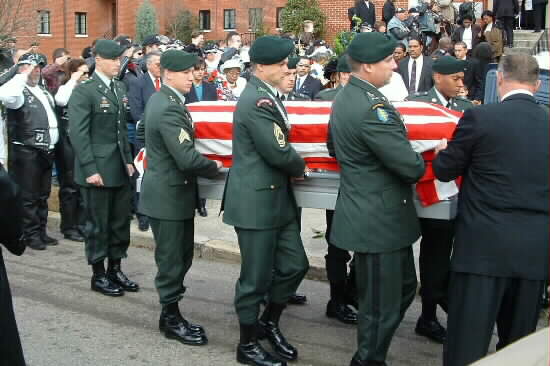
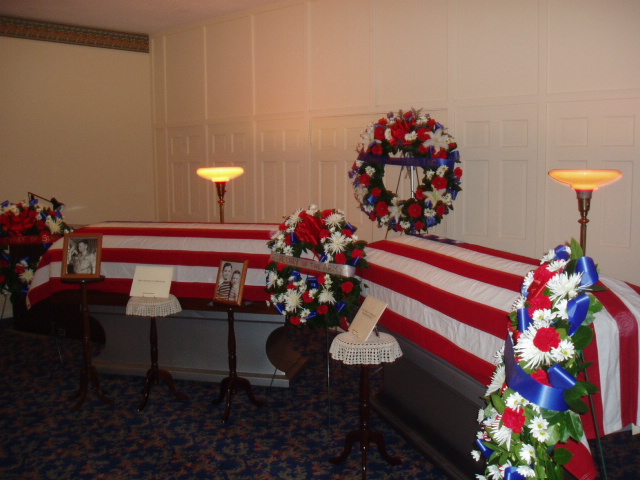
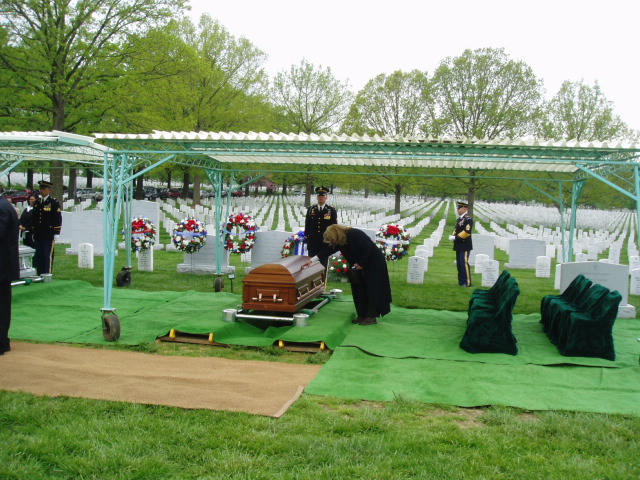
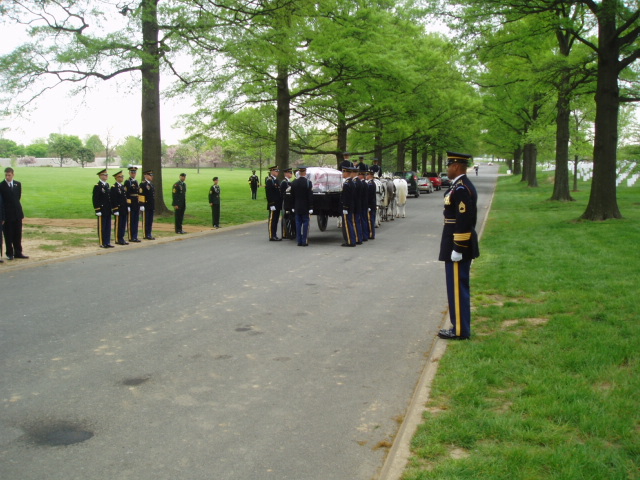
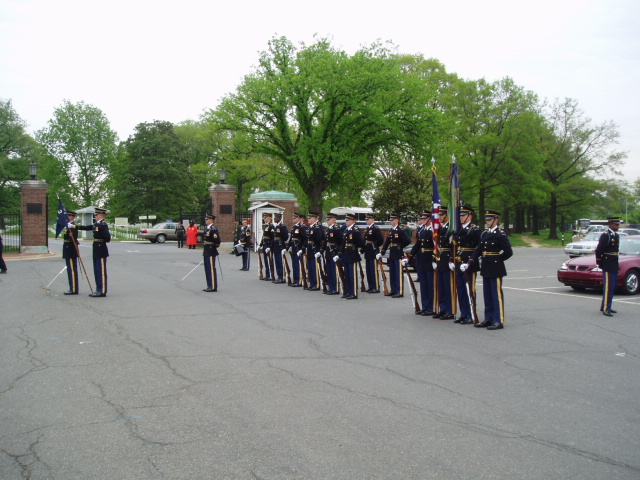
HANNA, KENNETH
- SGM US ARMY
- VIETNAM
- DATE OF BIRTH: 04/28/1933
- DATE OF DEATH: 02/07/1968
- BURIED AT: SECTION 60 SITE 8243
- ARLINGTON NATIONAL CEMETERY
Michael Robert Patterson was born in Arlington and is the son of a former officer of the US Army. So it was no wonder that sooner or later his interests drew him to American history and especially to American military history. Many of his articles can be found on renowned portals like the New York Times, Washingtonpost or Wikipedia.
Reviewed by: Michael Howard

